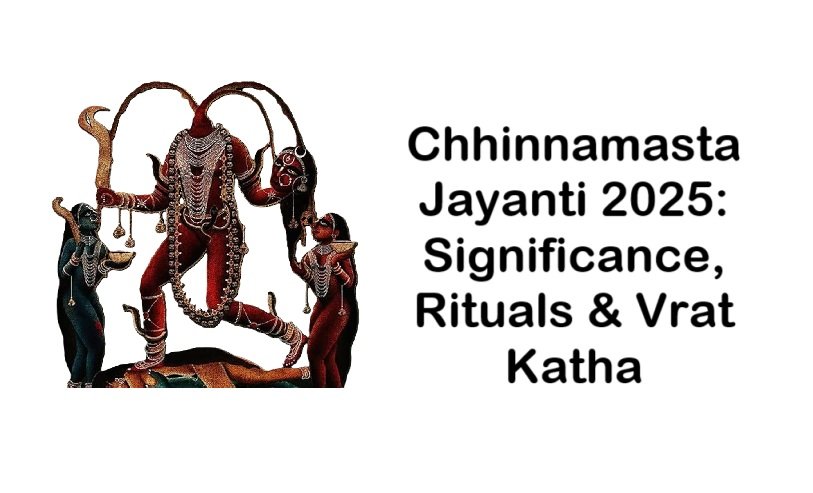
Introduction
Chhinnamasta Jayanti is one of the most significant and mystical observances in the Shakta tradition of Hinduism. It commemorates the divine and symbolic act of self-sacrifice by Goddess Chhinnamasta, one of the ten Mahavidyas. In 2025, Chhinnamasta Jayanti falls on Sunday, May 11, during Vaishakha Shukla Chaturdashi as per the Hindu lunar calendar.
This powerful day invites seekers, especially those inclined toward Tantric practices, to venerate the awe-inspiring energy of the headless goddess who symbolizes self-control, inner awakening, and the ultimate renunciation of ego and attachment.
Date and Muhurat of Chhinnamasta Jayanti 2025
- Chhinnamasta Jayanti Date: Sunday, May 11, 2025
- Chaturdashi Tithi Begins: 17:29 (5:29 PM) on May 10, 2025
- Chaturdashi Tithi Ends: 20:01 (8:01 PM) on May 11, 2025
Explore:
- Matangi Jayanti 2025 – Date, Significance, Rituals, and Vrat Katha
- 2025 Dasha Mahavidya Jayanti: Dates, Significance
Who is Goddess Chhinnamasta?
Goddess Chhinnamasta is the sixth Mahavidya among the ten fierce aspects of the Divine Mother. She is a representation of Praharsha and Rudra Shakti—joyful yet terrifying. Her name, Chhinnamasta, literally means “She who has severed her head.”
She is depicted as standing on a copulating couple, holding her severed head in one hand, and a scimitar in the other. Three jets of blood spurt from her neck—two directed toward her attendants, Dakini and Varnini, and one into her own mouth. This deeply symbolic imagery conveys messages of sacrifice, the transcendence of ego, and the cycle of life, death, and rebirth.
Tantric Significance and Worship Traditions
Goddess Chhinnamasta is primarily worshipped by Tantrics, Yogis, Aghoris, and Nath Panthis due to her fierce nature. However, common devotees can also worship her to seek protection from calamities, spiritual awakening, and freedom from emotional bondage.
According to the Chhinnamasta Tantra Shastra, even Lord Parshuram is said to have worshipped her. The great yogi Guru Gorakhnath, a founder of the Nath tradition, was also a devout follower. She is closely associated with the Narasimha Avatar of Lord Vishnu and sometimes referred to as Vajra Vairochani, linking her to both Vedic and Tantric traditions.
Chhinnamasta and the Cycles of Creation and Destruction
In the cosmic framework, Goddess Chhinnamasta represents the phase of destruction when creation is at its lowest and dissolution is at its peak. In contrast, when the force of creation dominates, Goddess Bhuvaneshwari presides. Thus, Chhinnamasta symbolizes the necessary force of destruction for renewal and transformation.
Her two companions, Dakini and Varnini, are manifestations of Rajas and Tamas, representing desire and ignorance. The act of feeding them her own blood signifies the subjugation of base tendencies and selfless sacrifice.
Spiritual Meaning and Inner Cultivation
The worship of Chhinnamasta is not for the faint-hearted or for those unprepared for deep introspection. It is said that only qualified seekers, initiated through proper guidance, should engage in full Tantric worship of the goddess.
Yet, her worship—even in simplified form—offers immense spiritual benefits:
- Freedom from Jiva Bhava (individual ego identity)
- Experience of Shiva Bhava (universal consciousness)
- Detachment from emotional and material bondage
- Attainment of inner bliss and self-realization
Her form urges devotees to look within, destroy the ego, and rise above physical desires.
Chhinnamasta Jayanti Vrat Katha (Story Behind the Festival)
Origin Story
Once, Goddess Parvati, along with her attendants Dakini (Jaya) and Varnini (Vijaya), went to bathe in the sacred Mandakini river. After bathing, the goddess was overwhelmed by Kshudagni (the fire of hunger), and so were her companions. They pleaded with the goddess to satisfy their hunger.
Initially, Parvati asked them to wait until they returned home. However, as their hunger grew unbearable, they once again pleaded, reminding her of a mother’s role in nourishing her children.
Moved by their devotion and suffering, Goddess Parvati did something extraordinary—she severed her own head with the tip of her nail. Three streams of blood flowed from her neck:
- One fed Dakini
- One fed Varnini
- One was consumed by the goddess herself, holding her severed head in her hand
From that moment, Parvati came to be known as Goddess Chhinnamasta, revered across all worlds for her supreme act of self-sacrifice and empowerment.
Rituals and Worship on Chhinnamasta Jayanti
While traditional Tantric worship is complex and often reserved for advanced practitioners, devotees can observe the day with simplified rituals:
1. Fasting and Purification
- Observers take a vow of fasting on Chaturdashi.
- A pure vegetarian Sattvic diet is followed by general devotees, while Tantrics may perform special offerings.
2. Altar Preparation
- An image or yantra of Goddess Chhinnamasta is installed on a clean altar.
- Red flowers, kumkum, sindoor, and hibiscus are offered.
3. Chhinnamasta Mantra Chanting
ऐं ह्रीं क्लीं चिन्नमस्तायै नमः
This bija mantra is recited 108 times using a Rudraksha mala.
4. Reciting the Chhinnamasta Stotra and Kavacha
Devotees chant her hymns and protective stotras to invoke her energy and seek blessings.
5. Meditation and Self-Reflection
Her worship is incomplete without inner silence and contemplation on the transient nature of ego and worldly attachments.
Relevance Across Traditions
Interestingly, Goddess Chhinnamasta transcends sectarian boundaries. She is worshipped by:
- Shakta Hindus as a form of Devi
- Tantric Buddhists (especially in Vajrayana) as Vajrayogini or Vajra Vairochani
- Even some Jain traditions have symbols aligning with her fierce form
Conclusion
Chhinnamasta Jayanti 2025 is a sacred opportunity to confront inner fears, overcome worldly illusions, and awaken the divine energy within. The terrifying yet compassionate form of the headless goddess invites us to cut through the ego, offer ourselves in service, and become one with the cosmic truth.
Whether you’re a devout spiritual practitioner or a curious seeker, the path of Chhinnamasta is a reminder that real transformation begins with surrender.







